Topic: Bioluminescence
Flying through the air on a summer's evening or sparkling in the ocean you may see magical flashes of light that signal some of nature's most enchanting creatures, those that are bioluminescent.
 Flying through the air on a summer’s evening or sparkling in the ocean, magical flashes of light signal some of nature’s most enchanting creatures, those that can generate their own light. Bioluminescence, the capacity of an organism to emit cold light by a natural chemical reaction, is an intriguing feature of creatures as diverse as squid, fish, fungi and beetles. Across the tree of life such light production has evolved independently at least 40 times and in reality more likely more than 50 times: here is convergent evolution on a truly impressive scale.
Flying through the air on a summer’s evening or sparkling in the ocean, magical flashes of light signal some of nature’s most enchanting creatures, those that can generate their own light. Bioluminescence, the capacity of an organism to emit cold light by a natural chemical reaction, is an intriguing feature of creatures as diverse as squid, fish, fungi and beetles. Across the tree of life such light production has evolved independently at least 40 times and in reality more likely more than 50 times: here is convergent evolution on a truly impressive scale.
Light-producing organisms are incredibly diverse
The wide distribution of bioluminescence points both to its critical ecological importance as well as its rampantly convergent evolutionary origins. Glowing species are known from almost all the major animal phyla as well as certain fungi, protists and bacteria. Even so, the evolutionary pattern of bioluminescence shows an irregular and scattered distribution, in some groups cold light is generated in every species (such as in the shimmering ctenophores or comb jellies), but in others it has evolved in just one or a few species (as is the case in ascidians or sea squirts).
Bioluminescent species predominate in the marine environment, especially at depth and in the open ocean where it provides the main light source. Indeed it has been reported that most marine species are capable of some form of bioluminescence. Nor is this surprising. Light is ideal way to communicate, disappear or hunt in the translucent, stable, and for the most part sunlight-deficient regions of the sea. Sunlight is reduced 10 times for every 75 metres depth below the surface, with permanent darkness existing below 1000m.
 A rich diversity of marine animals (at least 12 phyla) and a plethora of bacteria (e.g. Vibrio) and protists (most abundantly dinoflagellates) emit light, between them emitting across the entire spectrum, from violet to red. Most emit blue light as it travels fastest through open seawater, although greenish light is common in shallower or benthic habitats. Among the most charismatic of bioluminescent animals, we find flashing crustaceans such as shrimps and copepods which can dash away behind a ‘smokescreen’ of squirted light, shimmering jellyfish, pulsating comb jellies, squid and octopus with their glowing bodies and capacity to launch bioluminiscent mucus, annelids who when disturbed, release glowing ‘bombs’, hatchetfish which conceal themselves from predators below by matching the blue sea above them, sharks who follow suit as they lie in ambush. One must also mention those strange deep sea anglerfish which hunt using tempting glowing lures or in the case of loosejaw dragonfish employ red headlamps that are perilously invisible to others living in the depths. The biochemical basis and myriad ecological functions of this incredible marine light show are explored below, but first a brief aside on terrestrial and freshwater light-emitters:
A rich diversity of marine animals (at least 12 phyla) and a plethora of bacteria (e.g. Vibrio) and protists (most abundantly dinoflagellates) emit light, between them emitting across the entire spectrum, from violet to red. Most emit blue light as it travels fastest through open seawater, although greenish light is common in shallower or benthic habitats. Among the most charismatic of bioluminescent animals, we find flashing crustaceans such as shrimps and copepods which can dash away behind a ‘smokescreen’ of squirted light, shimmering jellyfish, pulsating comb jellies, squid and octopus with their glowing bodies and capacity to launch bioluminiscent mucus, annelids who when disturbed, release glowing ‘bombs’, hatchetfish which conceal themselves from predators below by matching the blue sea above them, sharks who follow suit as they lie in ambush. One must also mention those strange deep sea anglerfish which hunt using tempting glowing lures or in the case of loosejaw dragonfish employ red headlamps that are perilously invisible to others living in the depths. The biochemical basis and myriad ecological functions of this incredible marine light show are explored below, but first a brief aside on terrestrial and freshwater light-emitters:
While up to 80% of known luminescent organisms are believed to live in the marine environment, the remainder are almost exclusively terrestrial; perhaps oddly bioluminescence is very rare in freshwater habitats.
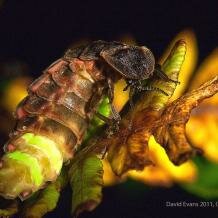 On land, best known are bioluminescent insects such as fireflies and glow-worms. Despite their names these are in fact the adult and larval stages of certain lampyrid beetles (e.g. Photinus, Photuris, Lampyris), bearing abdominal light organs. While larvae glow green to advertise their distatefulness to predators, adults frequently flash in a species-specific pattern to advertise for a mate. Female Photuris fireflies have been termed ‘femmes fatales’ for their sly trick of flashing in synchrony with females of other species, so luring males of these species to their doom. These deadly females make the most of their diet of males, using chemicals from their prey to synthesise their own anti-predatory defense chemicals. Eggs, larvae and adults of Pyrophorus click beetles (family Elateridae) are all bioluminescent and interestingly adults it appears that these insects emit an orange light as a sexual attractant but a green light for defence. The glowing larvae and larva-like females of phengodid beetles are another case of independent evolution of luminescence in beetles. So-called railroad worms (larvae of the phengodid beetle Phrixothrix) are unusual in being multicoloured: on each segment they have paired green glowing organs to deter predators (they are toxic to eat) and organs on the head that, uniquely among land living species, emit a red light.
On land, best known are bioluminescent insects such as fireflies and glow-worms. Despite their names these are in fact the adult and larval stages of certain lampyrid beetles (e.g. Photinus, Photuris, Lampyris), bearing abdominal light organs. While larvae glow green to advertise their distatefulness to predators, adults frequently flash in a species-specific pattern to advertise for a mate. Female Photuris fireflies have been termed ‘femmes fatales’ for their sly trick of flashing in synchrony with females of other species, so luring males of these species to their doom. These deadly females make the most of their diet of males, using chemicals from their prey to synthesise their own anti-predatory defense chemicals. Eggs, larvae and adults of Pyrophorus click beetles (family Elateridae) are all bioluminescent and interestingly adults it appears that these insects emit an orange light as a sexual attractant but a green light for defence. The glowing larvae and larva-like females of phengodid beetles are another case of independent evolution of luminescence in beetles. So-called railroad worms (larvae of the phengodid beetle Phrixothrix) are unusual in being multicoloured: on each segment they have paired green glowing organs to deter predators (they are toxic to eat) and organs on the head that, uniquely among land living species, emit a red light.
 Beyond the beetles, the larvae of two unrelated flies are also bioluminescent, namely Arachnocampa fungus gnats of New Zealand and Australia and in North America Orfelia fultoni. Predatory larvae of Arachnocampa hang in damp caves, dangling sticky glowing threads that attract and ensnare flying insects. Orfelia larvae build sticky glowing webs for the same purpose and primarily inhabit wet caves and riverside crevices. Other arthropods include certain springtails (Collembola), millipedes (e.g. Motyxia) and centipedes, which use light to warn of their toxicity. One tropical snail, Quantula striata, emits light, as do – for unknown reasons – a few earthworms (e.g. Diplocardia longa). Some fungi (e.g. Armillaria, Mycena, Omphalotus, Panellus, Pleurotus) emit an eerie glow called ‘foxfire’ that is thought serves to attract insects and hence aid in spore dispersal. Luminescent Photorhabdus bacteria live in the guts of parasitic microscopic nematodes. The worms infect insect larvae (attracted by the glowing worms) and then rely on Photorhabdus to poison their host, leaving the nematodes unharmed and protected from the host’s immune system while they feed and reproduce, ready for their next victim.
Beyond the beetles, the larvae of two unrelated flies are also bioluminescent, namely Arachnocampa fungus gnats of New Zealand and Australia and in North America Orfelia fultoni. Predatory larvae of Arachnocampa hang in damp caves, dangling sticky glowing threads that attract and ensnare flying insects. Orfelia larvae build sticky glowing webs for the same purpose and primarily inhabit wet caves and riverside crevices. Other arthropods include certain springtails (Collembola), millipedes (e.g. Motyxia) and centipedes, which use light to warn of their toxicity. One tropical snail, Quantula striata, emits light, as do – for unknown reasons – a few earthworms (e.g. Diplocardia longa). Some fungi (e.g. Armillaria, Mycena, Omphalotus, Panellus, Pleurotus) emit an eerie glow called ‘foxfire’ that is thought serves to attract insects and hence aid in spore dispersal. Luminescent Photorhabdus bacteria live in the guts of parasitic microscopic nematodes. The worms infect insect larvae (attracted by the glowing worms) and then rely on Photorhabdus to poison their host, leaving the nematodes unharmed and protected from the host’s immune system while they feed and reproduce, ready for their next victim.
Very few bioluminescent organisms have been found in freshwater, possibly due to the dynamic, light-scattering nature of the environment. Reports include only a few insect larvae and the limpet Latia neroides, which exudes green luminescent mucus to deter predators.
How life emits light: a tale of molecular convergence
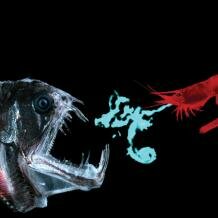 Bioluminescent light is produced as the result of a chemical reaction, typically the oxidation of a photon-emitting compound known as luciferin. Luciferin oxidation is controlled by an enzyme, generally a luciferase (or a photoprotein). To control light emission bioluminescent organisms tend to store luciferin and luciferase separately or keep luciferin hidden within a binding protein until needed. Photoproteins enable reaction control, as they bind the luciferin and oxygen separately until a final cofactor (e.g. Ca2+ or Mg2+ ions) triggers the oxidation reaction. As molecules luciferins are extraordinarily conserved across a range of unrelated taxa, although the structures of the best known luciferases are very different, so providing a special window on convergence. Not only are luciferases and photoproteins highly diverse, but taxon specific. Moreover, species that emit more than one colour (such as the railroad beetles and dragonfish) do so using multiple luciferases or photoproteins.
Bioluminescent light is produced as the result of a chemical reaction, typically the oxidation of a photon-emitting compound known as luciferin. Luciferin oxidation is controlled by an enzyme, generally a luciferase (or a photoprotein). To control light emission bioluminescent organisms tend to store luciferin and luciferase separately or keep luciferin hidden within a binding protein until needed. Photoproteins enable reaction control, as they bind the luciferin and oxygen separately until a final cofactor (e.g. Ca2+ or Mg2+ ions) triggers the oxidation reaction. As molecules luciferins are extraordinarily conserved across a range of unrelated taxa, although the structures of the best known luciferases are very different, so providing a special window on convergence. Not only are luciferases and photoproteins highly diverse, but taxon specific. Moreover, species that emit more than one colour (such as the railroad beetles and dragonfish) do so using multiple luciferases or photoproteins.
Four luciferins seem to drive the great majority of marine bioluminescence, although new luciferins continue to be described, for example in a clam (Phola), as well as various worms, echinoderms and hemichordates.
 In terms of convergence most remarkable is, perhaps, the luciferin known as coelenterazine. This nitrogen-ring based molecule is found in nine separate groups, ranging from the radiolarians (a group of siliceous protists), comb jellies (ctenophores), all cnidarians, a range of crustaceans (decapod and mysid shrimps, halocyprid ostracods, copepods), some brittle stars (ophiuroids), arrow worms (chaetognaths), vampire squid, free swimming tunicates known as larvaceans and some fish (e.g. Diaphus). Coelenterazine is typically synthesised from a tripeptide precursor (Phe-Tyr-Tyr), and those animals that acquire it through their diet seem to depend primarily on crustaceans such as ostracods and shrimp. Coelenterazine is oxidized by very taxon specific luciferases and photoproteins, again underlining the independent evolution of light production in each group.
In terms of convergence most remarkable is, perhaps, the luciferin known as coelenterazine. This nitrogen-ring based molecule is found in nine separate groups, ranging from the radiolarians (a group of siliceous protists), comb jellies (ctenophores), all cnidarians, a range of crustaceans (decapod and mysid shrimps, halocyprid ostracods, copepods), some brittle stars (ophiuroids), arrow worms (chaetognaths), vampire squid, free swimming tunicates known as larvaceans and some fish (e.g. Diaphus). Coelenterazine is typically synthesised from a tripeptide precursor (Phe-Tyr-Tyr), and those animals that acquire it through their diet seem to depend primarily on crustaceans such as ostracods and shrimp. Coelenterazine is oxidized by very taxon specific luciferases and photoproteins, again underlining the independent evolution of light production in each group.
Cypridina luciferin belongs to the same family as coelenterazine. It is found in myodocopid ostracods such as Cypridina noctiluca and Vargula hilgendorfi and is synthesised from a Trp-Ile-Arg tripeptide precursor. The midshipman toadfish (Porichthys) acquires cypridina luciferin (for use in the many photophores on its head and body,) by consuming ostracods such as Vargula. A few other fish (e.g. Pempheris, Parapriacanthus) retain the luminescent ostracods in their guts and so, unusually, use their digestive tract as a light organ.
Bacterial luciferin is a tricyclic molecule oxidized by an aldehyde and a luciferase, and these encoded by a genetically conserved ‘lux operon’. Where vast population densities of luminous bacteria occur, such as in warm, upwelling areas of the Indian Ocean, a form of quorum sensing seems to trigger this bacterial light reaction on a huge scale. This leads to glowing ‘milky seas’, tens of thousands of square kilometers in size, and visible from space. While most squid and many fish produce their own light, a number of them have independently acquired these symbiotic luminous bacteria. The bacteria are localized in light-producing organs that serve various functions, from the hunting lures of anglerfish and flashlight fish to the dazzling eye and tentacle spots of deep sea squid.
 Dinoflagellates are swimming protists, some of whom emit flashes of light when disturbed, so making the sea sparkle. Dinoflagellate luciferin is modified from chlorophyll (which is basically a tetrapyrrole) and in autotrophic species luciferin cyclically converts between photosynthesis during the day and bioluminescence at night. Some dinoflagellates, however, are non-photosynthetic and these must either consume chlorophyll or use a novel biosynthesis pathway. An estimated eighteen genera of dinoflagellates emit light (e.g. Pyrocystis, Protoperidnium, Gonyaulax, Noctiluca) and S.H.D. Haddock et al. (Annual Review of Marine Science 2: 443-493; 2010) remark that light production is so critical that these protists allocate energy to light emission before growth. Euphasiid shrimps also use dinoflagellate luciferin, likely due to chemicals retained from dinoflagellates that form part of their diet.
Dinoflagellates are swimming protists, some of whom emit flashes of light when disturbed, so making the sea sparkle. Dinoflagellate luciferin is modified from chlorophyll (which is basically a tetrapyrrole) and in autotrophic species luciferin cyclically converts between photosynthesis during the day and bioluminescence at night. Some dinoflagellates, however, are non-photosynthetic and these must either consume chlorophyll or use a novel biosynthesis pathway. An estimated eighteen genera of dinoflagellates emit light (e.g. Pyrocystis, Protoperidnium, Gonyaulax, Noctiluca) and S.H.D. Haddock et al. (Annual Review of Marine Science 2: 443-493; 2010) remark that light production is so critical that these protists allocate energy to light emission before growth. Euphasiid shrimps also use dinoflagellate luciferin, likely due to chemicals retained from dinoflagellates that form part of their diet.
Why life emits light: a tale of functional convergence
Bioluminescence serves many functions, both in the dark depths of the ocean and on land. Light emission is used as a means of defence, as an aid to hunt effectively or under the cover of darkness even to attract potential mates.
Defensive bioluminescence
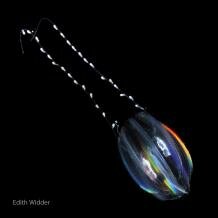 Many marine organisms startle would-be predators with flashing displays, notably in sparkling dinoflagellates, in the vampire squid (Vampyroteuthis) and in sternchaser lanternfish (myctophids), which emit a blinding flash and then dash away. This strategy is also reflected in the cascading colours of certain ctenophores (e.g. Beroe) and jellyfish, and in the general glowing response of many animals when disturbed, ranging from sea pansies (the soft coral Renilla) to syllid fireworms (the polychaete Odontosyllis).
Many marine organisms startle would-be predators with flashing displays, notably in sparkling dinoflagellates, in the vampire squid (Vampyroteuthis) and in sternchaser lanternfish (myctophids), which emit a blinding flash and then dash away. This strategy is also reflected in the cascading colours of certain ctenophores (e.g. Beroe) and jellyfish, and in the general glowing response of many animals when disturbed, ranging from sea pansies (the soft coral Renilla) to syllid fireworms (the polychaete Odontosyllis).
It has been reported that some bioluminescent species flash when under threat of predation in order to attract attention from higher order predators, which then swoop in to attack the attacker. This burglar alarm strategy is evidently employed by dinoflagellates being attacked by shrimps, the flashes of which serve to attract predatory fish and squid to tangle with the shrimps.
 Various jellyfish, ctenophores, crustaceans, squid, polychaetes, arrow worms and tube-shoulder fish can discharge a smokescreen of luminous particles or slime, evidently to confuse predators while they make their escape. For example, when disturbed the ostracod Vargula hilgendorfi (aptly known as the sea firefly) ejects a trail of flashing blue light; the copepods Gaussia and Peuromamma do the same; ostracods and oplophorid shrimps (e.g. Acanthephyra, Oplophorus) are known to squirt volumes of luciferin and luciferase from separate mouth tubes, creating disembodied blue clouds some distance from the animal. Coronate jellyfish Atolla and Periphylla produce internal waves of light and also secrete bright particles, while vampire squid release luminous secretions from its arm tips.
Various jellyfish, ctenophores, crustaceans, squid, polychaetes, arrow worms and tube-shoulder fish can discharge a smokescreen of luminous particles or slime, evidently to confuse predators while they make their escape. For example, when disturbed the ostracod Vargula hilgendorfi (aptly known as the sea firefly) ejects a trail of flashing blue light; the copepods Gaussia and Peuromamma do the same; ostracods and oplophorid shrimps (e.g. Acanthephyra, Oplophorus) are known to squirt volumes of luciferin and luciferase from separate mouth tubes, creating disembodied blue clouds some distance from the animal. Coronate jellyfish Atolla and Periphylla produce internal waves of light and also secrete bright particles, while vampire squid release luminous secretions from its arm tips.
In an almost comical manner, a number of species are known to release glowing body parts (termed autotomy) to misdirect the attention of a predator. Well described cases involve the glowing autotomized arms of brittle stars (ophiuroids), tentacles of siphonophore jellyfish and the deep sea squid Octopoteuthis deletron. Other examples include the flashing scales of polynoid scale-worms and the luminous ‘bombs’ released by a deep-sea annelid (Swima bombiviridis). A similar distraction technique is used by the squid Octopoteuthis, which lets its arms fall away from its body when threatened, with decoy light organs flashing at the arms tips.
squid counterillumination” src=”/thumbs/phpThumb.php?src=/images/full-size/BIOCHEM-MOLBIOL/squid_Gusano_luciernaga.jpg&w=218&h=218&zc=C&hash=9ba32621ef1f46712c41fa150ab35437″ alt=”squid counterillumination” width=”218″ height=”218″>Some luminous animals may still defend themselves even after being partly eaten by a predator. How? When chewed-off body parts continue to glow inside the predator cloak of its own invisibility vanishes and so makes it stand out to secondary predators. As for the other defence strategies, this is a convergent feature of many independent taxa, being reported in a pelagic sea cucumber (holothurian) Enypniastes eximia, polychaete annelids and coronate medusa jellyfish. When feeding, copepods also seem to reject flashing dinoflagellates presumably to avoid the unwelcome attention a glowing stomach might otherwise draw. Interestingly, many predators have evolved red or black stomach linings to counter the effects of this so-called sacrificial tag defense strategy.
Counterillumination is a form of camouflage commonly found in bioluminescent cephalopods (e.g. the firefly squid Watasenia scintillans), as well as fish and crustaceans. Using ventral photophores (light organs) these animals modify the angle, colour and distribution of light in order to make their silhouettes match the light coming from above. In this way they become almost invisible to predators peering from below. Excellent examples of counterilluminating fish include hatchetfish (e.g. Sternoptyx), myctophid lanternfish (e.g. Myctophus) and juvenile midshipman fish (Porichthys) that remain vulnerable in the water column before, as adults, they finally settle to the sea floor.
 A defence strategy underlying a number of luminous animals is aposematism, where light emission signals toxicity and distastefulness. Aposematic bioluminescence has been proposed, but not proven, for deadly jellyfish, brittle stars (ophiuroids) and polynoid scale worms (polychaetes covered in scales, or elytra). As mentioned above, aposematic signaling is a common explanation for light emission (and bright colouration) in terrestrial animals, most notably in bioluminescent beetles, millipedes and centipedes.
A defence strategy underlying a number of luminous animals is aposematism, where light emission signals toxicity and distastefulness. Aposematic bioluminescence has been proposed, but not proven, for deadly jellyfish, brittle stars (ophiuroids) and polynoid scale worms (polychaetes covered in scales, or elytra). As mentioned above, aposematic signaling is a common explanation for light emission (and bright colouration) in terrestrial animals, most notably in bioluminescent beetles, millipedes and centipedes.
Offensive bioluminescence
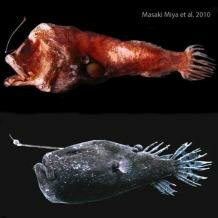 Some sinister deep-sea fish, cephalopods and even cnidarians cleverly attract prey using a glowing lure. Perhaps best known are the anglerfish (e.g. Bufoceratias), which have a blub-like culture of bioluminescent bacteria dangling at the end of a long lure (or esc). Most dragonfish (stomiids), such as Borostomias and Photostomias, have lure-like barbels, while the squid Chiroteuthis has glowing lures dangling from the ends of its tentacles. Certain octopus (e.g. Stauroteuthis) tempt prey to within their reach using luminescent suckers, swimming with their arms extended to form an alluring glowing web. The siphonophore jellyfish Erenna employ flickering lures on their hanging tentacles, strategically located adjacent to deadly stinging cells.
Some sinister deep-sea fish, cephalopods and even cnidarians cleverly attract prey using a glowing lure. Perhaps best known are the anglerfish (e.g. Bufoceratias), which have a blub-like culture of bioluminescent bacteria dangling at the end of a long lure (or esc). Most dragonfish (stomiids), such as Borostomias and Photostomias, have lure-like barbels, while the squid Chiroteuthis has glowing lures dangling from the ends of its tentacles. Certain octopus (e.g. Stauroteuthis) tempt prey to within their reach using luminescent suckers, swimming with their arms extended to form an alluring glowing web. The siphonophore jellyfish Erenna employ flickering lures on their hanging tentacles, strategically located adjacent to deadly stinging cells.
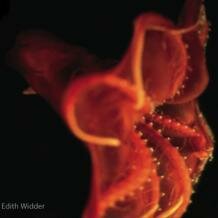 A number of deep-sea fish have remarkable anterior light organs that seem to function like headlights when searching the depths for prey. The aptly named stop light dragonfish (or loosejaw) Malacosteus is a prime example. It has sub-orbital photophores that emit red light and, in combination with a blue-green sensitive feedback system (this is because the fish cannot itself perceive red light), this allows it to detect prey that is insensitive to red light. Aristostomias and Pachystomias (which belong to the same family as Malacosteus) and the closely related stomiid Tactostoma possess similar red photophores. Certain flashlight fish, such as Photoblepharon, have bright post-orbital photophores that whilst bacterial in origin and emitting a blue-green light have also been implicated in illuminating the environment in the hunt for food. In the same way the lanternfish Diaphus may also rely partly on its own emitted light to detect its prey of copepods.
A number of deep-sea fish have remarkable anterior light organs that seem to function like headlights when searching the depths for prey. The aptly named stop light dragonfish (or loosejaw) Malacosteus is a prime example. It has sub-orbital photophores that emit red light and, in combination with a blue-green sensitive feedback system (this is because the fish cannot itself perceive red light), this allows it to detect prey that is insensitive to red light. Aristostomias and Pachystomias (which belong to the same family as Malacosteus) and the closely related stomiid Tactostoma possess similar red photophores. Certain flashlight fish, such as Photoblepharon, have bright post-orbital photophores that whilst bacterial in origin and emitting a blue-green light have also been implicated in illuminating the environment in the hunt for food. In the same way the lanternfish Diaphus may also rely partly on its own emitted light to detect its prey of copepods.
As a twist to the tale of defensive counterilluminators, cookiecutter dogfish sharks (Isistius brasiliensis) use offensive counterillumination. Their whole shadow is camouflaged, blending into the colour of overlying seawater via ventral photophores, save for a dark band at its throat/gill slits that mimics the shape of a small fish and hence attracts large predators such as tuna, which the shark then attaches to and takes a bite out of.
Certain predators seem to use bright flashes offensively rather than defensively, confusing or stunning prey while they attack. Good evidence for this comes from the squid Taningia danae that, when attacking bait, flashes wildly from large light organs at the tips of its hook-bearing arms.
Intraspecific communication
 Bioluminescent organisms frequently broadcast light signals to identify one another and attract potential mates. Sexual dimorphism is often accompanied with sex-specific light emission patterns, underlining the link in many species between bioluminescence and sexual selection. Light emission by the bioluminescent squid Watasenia and octopus Japetella has been recorded at atypical wavelengths. This suggests that these, and most likely other organisms, employ the equivalent of a ‘private channel’ which is used for species-specific communication.
Bioluminescent organisms frequently broadcast light signals to identify one another and attract potential mates. Sexual dimorphism is often accompanied with sex-specific light emission patterns, underlining the link in many species between bioluminescence and sexual selection. Light emission by the bioluminescent squid Watasenia and octopus Japetella has been recorded at atypical wavelengths. This suggests that these, and most likely other organisms, employ the equivalent of a ‘private channel’ which is used for species-specific communication.
On land, insects such as fireflies emit light for mate recognition and attraction. In the sea the minute ostracods have received attention for the way they use light signals to communicate with potential mates. Complex mate-following behaviour has been observed, with most males directing lavish light displays at females whilst a few sneaky males hover close by and given the opportunity lazily benefit from the others’ efforts.
Multifunctional bioluminescence
Luminosity frequently serves multiple functions, for lights in the darkness cannot help but attract curious prey as much as conspecifics. For example the characteristic glowing lures of anglerfish and dragonfish may attract mates as well as prey. In lanternfish (e.g. Diaphus, Myctophum), species and sex-specific photophore patterns have been linked not only to courtship signals but also to shoaling behavior and counterillumination. Once again this list could continue almost indefinitely, showing that in this realm as in all other areas of bioluminescence convergence is rife.
Cite this web page
Map of Life - "Bioluminescence"
https://mapoflife.org/topics/topic_592_bioluminescence/
July 31, 2017

